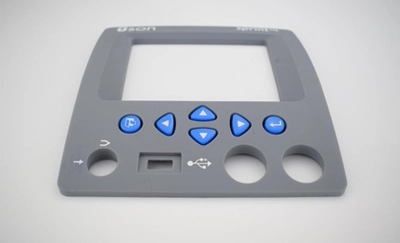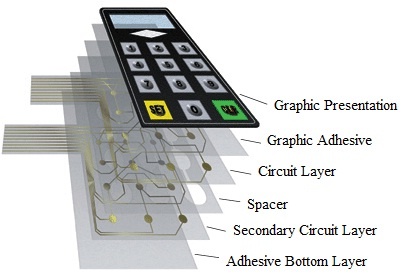Exploring membrane switch applications in high-risk environments
The Manufacturing Refine Behind Membrane Change: What You Required to Know
The production process behind membrane switches combines careful design, material choice, and quality assurance. It starts with understanding the ins and outs of membrane switch design and proceeds with various stages, including product options and printing strategies. Each phase plays a crucial function in ensuring performance and durability. The complexities of layer building and construction and the extensive testing requirements might disclose understandings that are not instantly evident. What exists past these fundamental elements?
Understanding Membrane Switch Over Design
Membrane switches may appear straightforward at first glance, their layout includes complex factors to consider that guarantee capability and toughness. The style procedure begins with an extensive understanding of individual needs, consisting of the user interface's designated application and environmental variables. Functional designs is a crucial component, as the design has to help with simplicity of usage while making sure that tactile responses fulfills customer expectations.Moreover, the layering of components, such as visuals overlays, glue layers, and conductive traces, should be specifically engineered. membrane switch. This split configuration not just influences the switch's responsiveness but additionally affects its longevity. Focus is provided to the sealing methods used to secure against moisture and dirt, which might compromise performance. In addition, style considerations extend to looks, where color design and visual clarity improve user experience. Eventually, the style of membrane changes balances functionality, customer experience, and durability, making certain that they meet the demands of numerous applications properly
Products Utilized in Membrane Switch Over Manufacturing
When selecting materials for membrane switch manufacturing, it is important to ponder both efficiency and sturdiness. The primary products consist of polyester and polycarbonate movies, which give flexibility and stamina. These films are typically covered with sticky to assure proper bonding to substrates. Conductive inks, generally made up of silver or carbon, are vital for producing electrical links within the switch, enabling dependable operation.Additionally, a safety layer, such as a hard coat, is frequently related to enhance scrape resistance and long life. The selection of backing material, such as acrylic or foam, can substantially influence the switch's responsive feeling and total user experience. In addition, numerous ecological elements, consisting of temperature and humidity, ought to direct product selection to assure peak efficiency in particular applications. Inevitably, the appropriate combination of products adds to the membrane switch's capability and life expectancy, making informed options vital for producers.
The Printing Refine: Creating Graphics and Text
The printing process in membrane layer button manufacturing plays a significant role in creating premium graphics and message. Numerous graphic layout strategies are utilized to guarantee visual allure and capability, while mindful ink selection techniques are necessary for longevity and efficiency. Comprehending these elements is essential for attaining best cause membrane button design.
Graphic Design Techniques
Graphic layout methods play an essential duty in the printing procedure of membrane layer buttons, as they define just how graphics and text will eventually show up on the final item. Efficient graphic layout includes the strategic use of formats, colors, and fonts to improve readability and aesthetic charm. Developers often utilize vector graphics for scalability, guaranteeing that photos continue to be sharp at different dimensions. Furthermore, focus to comparison and placement is important, as it influences user interaction and aesthetic high quality. The incorporation of branding aspects, such as logo designs, should be handled with like maintain brand integrity. Generally, thoughtful graphic layout methods add substantially to the performance and appearance of membrane layer buttons, impacting user experience and product performance.
Ink Choice Techniques
Picking the appropriate ink is essential for achieving the desired visual high quality and durability in membrane layer button manufacturing. Numerous ink kinds are used, consisting of solvent-based, water-based, and UV-curable inks. Each type supplies distinctive features, such as versatility, resistance, and attachment to ecological aspects. Solvent-based inks are commonly preferred for their sturdiness and vivid colors, while water-based inks are more eco-friendly but may have restrictions in attachment. UV-curable inks supply fast treating and durable efficiency. In addition, shade matching techniques ensure that the picked inks straighten with style specs. Eventually, the choice of ink need to take into consideration factors such as application technique, substratum compatibility, and end-use demands to attain remarkable cause membrane layer switch graphics and message.
Layer Building And Construction and Setting Up

Material Option Refine
A mindful choice of materials is necessary in the manufacturing procedure of membrane layer switches, as it straight affects performance and resilience. The main materials made use of consist of polyester, polycarbonate, and numerous conductive inks. Polyester is often favored for its outstanding resistance to chemicals and abrasion, making it appropriate for rough environments. Polycarbonate, on the other hand, offers superior clearness and influence resistance, which is advantageous for applications requiring visibility and robustness. Conductive inks, commonly made up visit this page of silver or carbon, are vital for creating reputable electrical paths. Furthermore, the selection of glue products affects the general integrity of the button - membrane switch. Assessing aspects such as environmental exposure, tactile feedback, and aesthetic needs overviews producers in selecting the most effective materials for their certain applications
Layer Attachment Methods
Adhering layers in membrane switch building is an important procedure that guarantees functionality and durability. Numerous attachment browse around this site methods are used to safeguard perfect bonding in between layers, which usually include using adhesives, heat, and pressure. Pressure-sensitive adhesives (PSAs) are generally utilized for their convenience of application and immediate bonding capabilities. Furthermore, thermal bonding methods can be used, where heat is utilized to turn on adhesive residential or commercial properties, safeguarding a solid bond. The option of bond method greatly relies on the products involved and the specific application requirements of the membrane layer button. Proper placement and consistent application of adhesives are vital to avoid problems, securing the switch operates efficiently throughout its intended life-span.
Quality Assurance Steps
Assuring quality control during the layer construction and assembly of membrane switches is vital for maintaining performance and dependability. This process normally includes several crucial procedures, consisting of comprehensive evaluations at each phase of production. Suppliers make use of innovative screening methods, such as peel tests and attachment analyses, to verify the honesty of layer bonds. Furthermore, visual assessments are conducted to recognize any problems in printing or product disparities. Ecological problems, such as temperature and moisture, are meticulously kept an eye on to ensure perfect treating and attachment. Additionally, normal calibration of devices helps maintain specific production requirements. By implementing these high quality control actions, manufacturers can substantially lower the threat of item failure, assuring that the last membrane switches fulfill the called for requirements and client expectations.
Examining and Quality Assurance Procedures

Technologies in Membrane Switch Technology
As innovations in modern technology continue to evolve, membrane layer switches are gaining from ingenious developments that boost their performance and user experience. One noteworthy technology is the combination of capacitive touch technology, which permits for more instinctive and responsive customer interfaces. This shift not just improves aesthetics however also lowers mechanical deterioration, expanding the lifespan of the switches.Additionally, innovations in graphic overlay products have caused boosted toughness and resistance to environmental variables such as dampness and UV light. These products now offer enhanced clarity and illumination, more raising the aesthetic appeal.Furthermore, the incorporation of smart innovation is changing membrane switches over right into interactive control panels, making it possible for connectivity with IoT gadgets. This connectivity cultivates a seamless customer experience, leading the way for applications in numerous sectors, from medical care to consumer electronics. Jointly, these advancements placement membrane switches over as crucial elements in modern-day tool design.
Frequently Asked Concerns
For how long Does the Membrane Layer Switch Manufacturing Process Take?
The duration of the membrane switch manufacturing process can vary significantly. Aspects such as intricacy, products utilized, and manufacturing quantity impact timelines, with regular manufacturing varying from a couple of days to numerous weeks for conclusion.
What Are the Usual Applications for Membrane Layer Buttons?
Membrane layer buttons are commonly utilized in various sectors, consisting of auto controls, house devices, clinical tools, and customer electronics (membrane switch). Their adaptability and longevity make them ideal for applications calling for straightforward user interfaces and trustworthy efficiency in diverse environments
Can Membrane Switches Over Be Personalized for Certain Requirements?

What Is the Life-span of a Typical Membrane Switch Over?
The life expectancy of a normal membrane layer button differs, but generally, it ranges from 1 to 5 million cycles. Elements such as usage, atmosphere, and worldly top quality greatly influence durability and overall performance in time.

Are Membrane Layer Switches Over Eco Pleasant?
The environmental friendliness of membrane switches over differs. Some products utilized may not be recyclable, while others can this content be environment-friendly. The general impact relies on making materials and techniques, demanding cautious consideration throughout option and disposal. The manufacturing process behind membrane switches combines mindful style, material option, and high quality control. It begins with understanding the details of membrane layer switch layout and advances through numerous stages, including material selections and printing methods. When selecting products for membrane button manufacturing, it is important to ponder both performance and resilience. A mindful choice of products is necessary in the manufacturing process of membrane layer switches, as it straight influences capability and sturdiness. The choice of bond method mainly depends on the materials included and the specific application demands of the membrane switch.